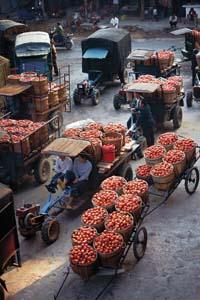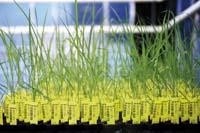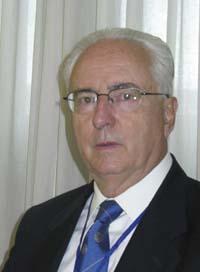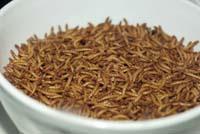How to feed the world

In the 1950s, one billion people were hungry in the world. Currently, the number of deaf people is similar; the difference is that they receive the minimum calories needed a day, from 2 billion to 5.7 billion. Thus, Professor of Biochemistry and Molecular Biology, Francisco García Olmedo, said that in recent decades there have been "more achievements than errors" in food production.
García Olmedo recently participated in the congress held in Bilbao by the EurSafe association. EurSafe is a European association dedicated to the ethics of agriculture and food, and Global food security: Ethical and legal challenges has been the theme of this year's congress (Global food security: ethical and legal changes). The professor gave a lecture entitled Feeding nine billion people (9 billion people feeding).
After the talk, Elhuyar has had the opportunity to conduct an interview. In his opinion, hunger remains the main problem of humanity and there are great imbalances, "but to me it seems positive that the number of people who have grown so much but who have been hungry is not greater than before." And to achieve this, he believes that the contribution of agriculture has been fundamental, especially the genetic improvement of plants.
There are many examples of this, such as rust resistant wheat varieties. These varieties spread all over the world and cause in many places duplicities or triple productive. In Mexico, 750 kilos per hectare went from 1950 to 3,200 kilos in 1970. Another example is the success of hybrid rice in China.
In other cases, changes in land ownership or the farming system, such as irrigation or fertilization, led to increased production. In Argentina, for its part, two types of changes have been introduced: genetically modified soy allows conservation agriculture, since the seed is resistant to herbicide glyphosate, so it can sow directly without removing the remains of the previous crop. With this system, GM soy has become the basis of the country's economy.
After the Green Revolution

They are all examples of the green revolution. García Olmedo has no doubt that it has been beneficial: "The priority is to feed people, even if this has side effects. Moreover, while some believe otherwise, new varieties need less land, water and energy than previous ones."
Therefore, García Olmedo believes that genetic improvement and biotechnology will remain "key" in the future, although it will not be enough with it: "Food production to feed 9 billion people must increase by 70% to 100%, which will not be possible only with GMOs."
Thus, among other technologies, García Olmedo has announced the importance of precision agriculture.
This agricultural system uses computer means to measure all soil parameters and know exactly how much seeds, water, fertilizers and pesticides should be deposited at each point. "In this way, on the one hand, soil fertility is maximized and, on the other, the cost and environmental impact are drastically reduced," explains the professor. He adds that computing and proper data management will also serve to combat climate change.
More answers
In addition to García Olmedo, other researchers have analyzed the issue. Food Security: the Challenge of Feeding 9 Billion People Under the title Change in food for 9 billion people, the journal Science published an analysis in February. Among the signatories are researchers from the universities of Oxford, Stirling and Essex, the Science Office of Great Britain and the biotechnology company Syngenta.

The authors of the analysis consider that the global strategy should be elaborated and applied, highlighting five aspects. The first is to "reduce the difference between what land can give and what it delivers." For this, among other things, the technical factors that enable fertility (irrigation systems, fertilizers, machinery, pesticides...) should be available to all producers and, subsequently, the producer should have access to the global market.
The importance of genetic technology has also been highlighted. They have announced that in the next decade "complicated genetic transformations" will be carried out and thus drought resistant plants, for example. In addition, it has been announced the creation of cloned animals immune to diseases and plants that allow reducing methane emissions to the atmosphere than usual to feed the animals. However, they also warn that if the benefits of biotechnology are exaggerated, it can lose credibility.
Waste, diet and aquaculture
Continuing the analysis, thirdly it has been proposed to "reduce waste", since between 30% and 40% of food is lost in both developing and industrialized countries. In the former, the lack of adequate warehouses is the main cause of loss; in the latter, market factors, such as appearance requirements or too narrow expiration dates. To solve this, the authors of the article consider that investments are necessary to improve infrastructure and technology, as well as adequate training and regulations.
Then, they have focused on diet. According to them, the efficiency of the transformation of plant matter into animal matter is 10%, so it seems evident that with the same surface of earth it would be possible to feed more people, instead of being omnivorous, that all are vegetarian.
This argument, however, has been considered a "simplicity": many of the areas used for livestock grazing cannot be turned into orchards; some animals, like pigs, grow with remnants of human food; they have great cultural and economic importance in many places. However, there are countries that have recognized the desirability of reducing meat consumption and that this point requires a thorough analysis.

The last aspect mentioned by researchers is aquaculture. 3 billion people receive 15% of the protein they eat thanks to fish and other aquatic animals and researchers believe that this proportion can be increased, especially by using genetic transformation techniques. However, it has been considered that the possible environmental impacts of the development of aquaculture must be taken into account.
They conclude that the goal is not as simple as increasing productivity. The goal is to optimize with production, the environment and social justice in mind.
In other publications, such as the July journal Nature, experts have reached similar conclusions. They are clear that there are no unique or easy solutions, but everyone highlights that biotechnology will play a fundamental role in the coming decades. However, it may be advisable to recall the observation made in the Science analysis that it is dangerous to overexalt biotechnology, since the credibility of such technologies is at stake.

Buletina
Bidali zure helbide elektronikoa eta jaso asteroko buletina zure sarrera-ontzian











